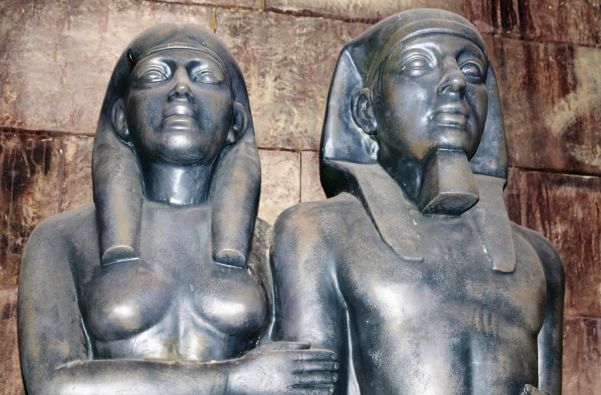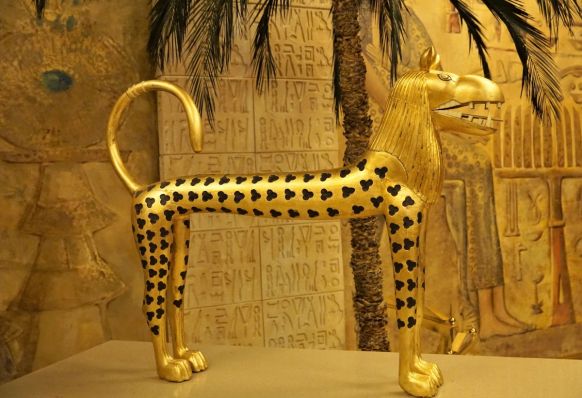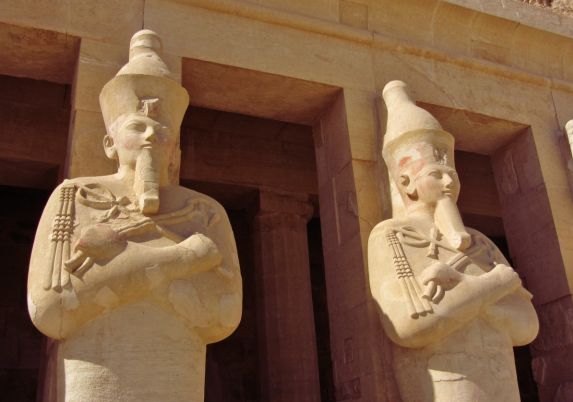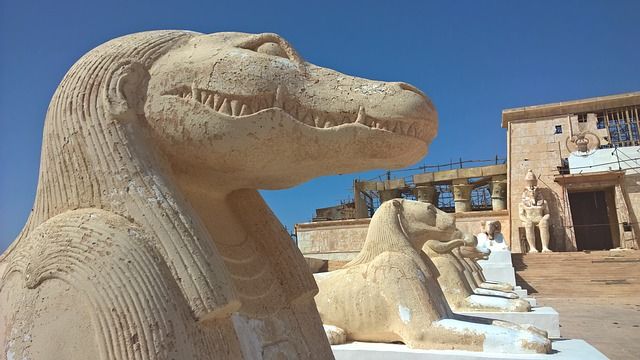Egyptian Sculpture – History, Symbolism and Representation
Contents
What is Egyptian Sculpture?
Ancient Egyptian Sculpture was closely associated with Egyptian architecture mostly centered around the temple and the funerary tomb. The temple was built as if it were the tomb or eternal resting place of a divinity whose statue was concealed within a succession of enclosed halls, open at one point to view only for a short time, the sun, moon or a particular star coming from a point on the horizon, whose rays shone directly on the interior of the shrine.
These divine statues were consulted as oracles and were rarely of imposing size. Sculptors also employed wall reliefs, column capitals, colossal figures guarding the pylons and long avenues of sphinxes. The mural illustrations on the temple walls typically depicted the piety of the pharaohs, as well as their foreign conquests.

How did Egyptian sculpture develop?
Despite the richness of the materials and the amount of production, Egyptian sculpture changed gradually in a way that it is not easy to trace a precise evolutionary path. Thus, from the earliest dynasties we find a fully developed art. Even at this early stage, Egyptian artists demonstrated great mastery in three-dimensional sculpture, hard stone and bronze sculpture and there is no archaic prototype to illustrate how this mastery was achieved. Hence the Egyptian culture has not yet illuminated as to its prehistoric art forms, nor is there known to be an extant foreign language or skill set that they have borrowed or acquired, except possibly the art of Mesopotamia in modern-day Iraq. Thus in general, regardless of its origin, Egyptian art during the historical period is marked more by the continuity of its evolutionary changes. Still, Egyptian sculpture to some extent can be distinguished from period to period.
Egyptian Stone Sculpture
It was in the late second and early third dynasties, from about 2,700 B.C., that what might be called the characteristic ancient Egyptian style of stone sculpture was established, a style that is transmitted through some 2,500 years to the Ptolemaic period with only exceptional modifications. Likewise, the predominant characteristics of this style are the regularity and symmetry of the solid and four-quadrant figures either standing or seated.
Michelangelo is the sculptor most reputed for having believed that a block of stone contains a sculpture, as in embryo, and that it is the artist’s task to reveal it. Therefore, the typical ancient Egyptian full figure gives a strong impression of the block of stone from which it was carved. The artists removed an absolute minimum of the rough stone, commonly leaving the legs fused in a solid mass to a back pillar, the arms attached to the sides of the body, while they were welded into figures seated on their chairs. Even when these sculptures appear clumsy, they convey an impression of severe elegance, purity of line suggesting by their tension, a restrained energy.
The first stages of the realization of a statue, like relief and painting, involved the elaboration of a preliminary sketch. A rough shape is given to a block of stone, and the figure to be carved was drawn on at least two sides to give the front and side views. Later, a grid of squares ensures that the proportions of the statue would be made exactly according to the rules that set the principles in dynastic times. The drawing masters, some of which have survived, were available for reference. Thus, the seated figure of Thutmose III, 1504-1450 B.C., was first sketched in red and then outlined in black, marked with a grid of small squares finally oriented. Thus, master craftsmen after years of practice could work instinctively, but inexperienced sculptors would keep those drawings on hand for easy reference.
Sculpture during the ancient Egyptian Empire
The art of Sculpture in the ancient empire centered around the city of Memphis, although the Delta, Abydos, the neighborhood of Thebes and Elephantine also provide examples of some of its later phases. None of the temples from this period have survived. Similarly, the sculptures come exclusively from tombs and the character of these Memphite sculptures are strongly naturalistic in comparison to later Egyptian art. The portrait statues are varied and often striking in character, while the murals depict numerous scenes from daily life. Similarly, widespread or typical forms include the monumental sphinx of Giza and statues of Chephren, the builder of the second pyramid.
The naturalistic tendency of this Memphis style has led to a peculiar treatment of the eye, a technique in the statues of this period (of limestone, wood and bronze, but not in the statues made of basaltic rocks), although they suspended it later. The pupil was represented by a set of nails in shiny silver in rock crystal or enamel, the dark eyelashes were made of bronze.
The heads of these statues of the ancient empire reveal a marked Egyptian type, though not entirely, for they were in some cases mixed with Negroids and other foreign races. Although slender body forms were represented, short, stocky, and muscular bodies were sometimes the most common occurrences. Since most representation was of middle-aged men and women, it appears that childhood and old age were not fundamental paradigms in later life. In general, the faces reflect a calm, happy people, for whom future life offers no great change or uncertainty. Likewise, wall sculptures and hieroglyphs executed in bas-relief were usually finely carved.
In this sense, unfinished statues provide useful evidence of the processes involved. Thus, most of them demonstrated that the work proceeded uniformly on all sides, thus maintaining the balance of the figure. Similarly, parts of a composite statue were intended to be made, and the top of the head, left in rough to fit a crown or a wig of other material. The surface of the face in some cases appeared to be ready for final smoothing and painting, but the guidelines are still there indicating the hairline and the middle plane of the face. Similarly, somewhat thicker line work is seen, noting the outline of the eyes and eyebrows done in a marked way to make it look as if the work had been planned, cutting these to inlay other stones so that the head would be very realistic when finished

Sculpture of the Egyptian Middle Empire
The sculptural art of the period known as the Middle Empire can be divided into two sub-periods: The First Theban period, from the 11th to the 15th dynasty and the Hyksos period, from the 15th to the 18th dynasty. At that time, the center of Egypt’s government had shifted from Memphis to Thebes. The later period of the Memphite rule and dynasty (Middle Empire), produced sculpture of lasting value, but in the later period of Usertesens, there was a renaissance of Egyptian creativity. In general, sculpture was simply a continuation of Memphis art, but some changes were already evident. There was a general desire for larger statues of pharaohs, while body forms began to acquire thinner legs, arms and trunks. Thus wall sculptures focused on similar subjects were less individual and less natural and, in many cases, wall paintings were replaced by relief sculptures. The twelve (12) statues of the Karnak temple dynasty reveal that votive offerings of statues were not uncommon, while the fine statue of Sebekhotep III (Louvre, Paris) of the 13th dynasty reveals a new departure in the sculptor’s art.
Egyptian Sculpture of the New Empire
The early portion of the New Empire of Egypt had freed itself from the rule of Hyksos and expanded its empire to include Syria, Asia Minor and Cyprus in the north and east and Nubia and Abyssinia in the south. Thus, several large temples were erected, especially during the rule of Seti and Ramses II, which led to numerous commissions for new sculptures. Thus, from the monumental temples it naturally led to monumental statuary, the statues of Amenophis III. at Thebes, 52 feet high, that of Ramesses II. at Ipsambul, 70 feet high, while the sculpture of Ramesses at Tanis, was 90 feet high except for its pedestal. Likewise, the slender proportions of the human form were popular and were continued to still more advanced forms, particularly in the bas-reliefs of the new Empire. likewise, the simplicity of dress, of earlier times, was now replaced by richer garments and more elaborate accessories, while crowns were not uncommon. Another major change was in the ornamentation: overseas, varieties of fauna and flora, as well as foreign men and women, were depicted more frequently and in greater variety than before.
Egyptian Sculpture during the Greco-Roman period
In this period of classical antiquity, when Egypt was subdued by Alexander the Great, its art did not change, from today to tomorrow, to please these new and powerful Greeks. However, the Ptolemaic temples, especially the column capitals, were not built like those of the Greek temples, in the Hellenistic style. Similarly, the Ptolemaic statues remained in Egyptian art. So, while the successor of Alexander the Great became pharaoh, they did not convert Egyptian art into Greek. However, the development of Greek cities in Egypt, which had been going on since the 7th century B.C., plus the Macedonian conquest of Egypt led to a mixed Greek-Egyptian style of art. Likewise, although the Romans continued to restore the temples of the ancient and middle empire in the Egyptian style, they also encouraged a form of sculpture of classical iconography and motifs to take precedence over an Egyptian style.
Royal Egyptian Sculpture
This sculpture is the sequence of formal royal sculpture, however, it shows more clearly the changes in detail and attitude that occurred over many centuries of Egyptian history. Unfortunately, very little royal sculpture has survived from the earliest periods, but one of the oldest examples is also one of the most impressive. It is the life-size limestone statue of King Djoser, dating from 2,660-2,590 B.C., found in a small compartment in the Step Pyramid temple complex, which was planned by the architect Imhotep (Egyptian Museum, Cairo). Once in place, the statue would never be seen by the eyes of the living.
It was made to provide an abode for the king’s ka after his death and was walled into a niche. Two holes were left in front of the eyes that could look out into the adjacent chapel where daily offerings were to be made. The king, seated on a square throne, is wrapped in a cloak. The face, framed by a full wig, is impassive and full of Majesty conveyed despite the damage caused by the thieves who gouged out his inlaid eyes. Small statues of nobles of the first three dynasties, seated in the same position with the right hand on the chest, convey a strong impression of the density of the stone from which they were carved.
In this regard, the magnificent Diorite statue of Kefren, dating from .2,500 BC. (Egyptian Museum in Cairo), built from the second pyramid of Giza, once stood with 22 people in the long corridor of the valley temple. The posture of the king has changed somewhat since the Zoser statue, and both hands now rest on the knees. The detail of the body, not wrapped in a cloak, is superbly executed. Protected by the falcon of the god Horus, the king sits alone in the quiet certainty of his divinity. This statue was intended to be seen in the temple, and the king’s power is underscored by the design carved into the sides of the throne that symbolized the union of the kingdoms of upper and lower Egypt with a knot of papyrus and lotus plants. Likewise, sculptors represented the rulers of the ancient kingdom as gods on earth. Thus, during the Middle Kingdom the surviving fragments of royal statues show a line of rulers who had achieved their divinity by their own power and force of personality. The aloof and solitary character of royalty appears in their portraits, but is combined with the awareness of a human personality beneath the symbols of kingship. The heads and statues of these rulers of the middle kingdom give the impression of royal portraits, carved by craftsmen of consummate skill.

Types of Egyptian Sculpture
Tomb and Temple Sculpture
The Egyptian art of sculpture was made to be placed in tombs or temples and was generally intended to be seen from the front. It was also important that the face always looked forward, into eternity, and that the body was seen from the front vertically and rigidly, with all planes intersecting at right angles. Variations sometimes occurred, for example, large statues were made to look slightly downward toward the viewer, but examples where the body is made to bend or the head to turn is very rare in formal sculpture.
It is generally accepted that the best craftsmen worked for the king and the patterns followed by others producing sculpture in stone, wood and metal for their subjects throughout Egypt. Thus the Middle Kingdom saw in particular the production of many small statues and figures that were placed in the tombs of quite ordinary people to act as substitutes for the body if the body should be destroyed, to provide an eternal abode for the ka.
Likewise, quality was desirable, but was not particularly important, since the statue was inscribed with the name of the dead person who was identified with it. In fact it was possible to take over a statue by simply altering the inscription and substituting another name. This was done even at the highest level, and there were Kings who often usurped statues of previous rulers. It is also believed that it is possible to destroy the memory of a hated or feared ancestor by hacking the names and titles of his monuments. This happened to many of Akhenaten’s statues, and Hatshepsut’s names were erased by Thutmose III.
Private Sculptures of Egyptian Sculpture
Private sculptures, like the royal ones were imitated, and were placed very much in the ritual tradition. Thus, craftsmen of later periods, particularly those who worked in wood, often produced small figures of great charm and did not feel bound by religious convention. These small figurines were often made to serve a practical purpose and carried containers of cosmetic substances, which were later buried among the personal possessions of their owners.
Egyptian Statues and Statuettes
Egyptian artists were producing a wide variety of small figurines in clay, bone and ivory, before the emergence of a formal style of sculpture at the time of the unification of the two lands of Egypt. Fragile figurines have been found in prehistoric tombs. Likewise, the tradition of making such objects survived into the new kingdom. Similarly, bone and ivory were used to make stylized female figurines of elaborate workmanship between 4,000 and 3,000 BC. Likewise, clay, which was easier to manipulate, was molded into representations of numerous species of animals, easy to identify because their characteristics were captured by the keen observation of their sculptors.
Great sculptures of Egyptian Art
Pharaohs commissioned rigid monumental statues to glorify themselves while they were still alive. The larger the state the more powerful the ruler. The most prolific creator of pharaonic statues was Ramses the Great, whose likeness is found in the colossus of Abu Simbel and other sites around Egypt.
In this sense, very early portrait art created its own rigid conventions, whereby, the markings of a grid guided the sculptor in his work. Thus, for a long time it was assumed that it was just a device commonly used by artists to enlarge any small sketch. However, it was later observed that the squares always intercepted the bodies in the same places, therefore, these instruments proved to be units of the canon of Egyptian sculpture. Similarly, a standing figure was composed of eighteen rows of squares (not counting the nineteenth row for the hair above the forehead). However, the Egyptians were never able to make free standing human sculptures. Therefore, the figures were either seated or emerging from a wall. Likewise, when pharaohs and their queens were sculpted together the king usually wore a headdress and skirt and his wife wore a tight, revealing dress. Similarly, standing sculptures were characterized by clenched fists, arms stiff at the sides, two feet firmly on the ground with the left foot forward, but the body going nowhere.
The Sphinxes
The Sphinx (near the pyramids at Giza) is the famous colossal statue with the body of Lion and head of a Pharaoh God. Located in a pit beside the pyramids of the Nile, it is 242 feet long and 66 feet high and is reached on foot through a temple of huge rectangular blocks of stone. The sphinx faces east toward the Nile and guards the entrance to the pyramid complex. Although it is a massive statue it is dwarfed by the pyramids and barely visible in front of them from a distance.
In this regard, in the Sphinx Alley in Luxor lie the remains of hundreds of ancient sphinxes have been found and have recently been renovated and put on public display. Many were found on a road that had been identified as the ceremonial route of the “Sphinx Alley”. The Sphinx Alley, also known as the Kabash route, connected the great temple of Karnak in ancient Thebes to the temple of Luxor. Thus, the ancient Egyptians walked along the route once a year to carry the statues of the gods Amun, Supreme God King of ancient Egypt and Mut, goddess revered as mother, in a symbolic repromulgation of their marriage.

Main representatives of Egyptian Sculpture
Surviving examples of Egyptian Sculpture
The statues and reliefs are mostly found in the temples of Abydos, Thebes, Edfou, Esneh, Philae and Ipsamboul, in the tombs around Memphis, Beni Hassan and Thebes and especially in the Museum of Giza. There are also important collections of ancient Egyptian statues in the Louvre Museum, Paris, the British Museum, London, the Metropolitan Museum of Art, New York, the Vatican, Rome, the Archaeological Museum, Florence, the Egyptian Museum of Turin, Turin, and the Royal Museum, Berlin. Other collections are in the United States, at the J Paul Getty Museum, Los Angeles; the Museum of Fine Arts, Boston; the University of Pennsylvania Museum, Philadelphia; and Johns Hopkins University.
In this sense, very few sculptors of ancient Egypt are known because most of the sculptural works do not know who made them because they do not have the name of their authors. Some of the most representative sculptors were:
Aacheperkareseneb son of Nebiaut, was a sculptor of Ancient Egypt. The name appears on a stele he carved for his father, called Nebiaut, it is not clear if he carved the piece or directed it. However, he must have worked in the area of Thebes, as it was the main center of worship of God. Similarly, Men was a sculptor and architect of Ancient Egypt; during the reign of Pharaoh Amenhotep III and his son Amenhotep IV. He carved a relief on a rock stele in Aswan, portrayed with his son the architect and sculptor Bek. On that stele, Men is named the supreme artist of the king’s great monuments.
For his part, Bek, son of Men, also a sculptor of Ancient Egypt, worked under the orders of Akhenaton in the mid-fourteenth century B.C. His works express the exaggerated realism, also called degenerate expressionism, promoted by Akhenaton. The figures impress by the perfection of the sculpture of the features and contours of the faces. Similarly, Tuthmose (circa 1330 BC) was a craftsman and master sculptor during the reign of Akhenaten, his most famous work is the sculpture of the famous head of Queen Nefertiti.
